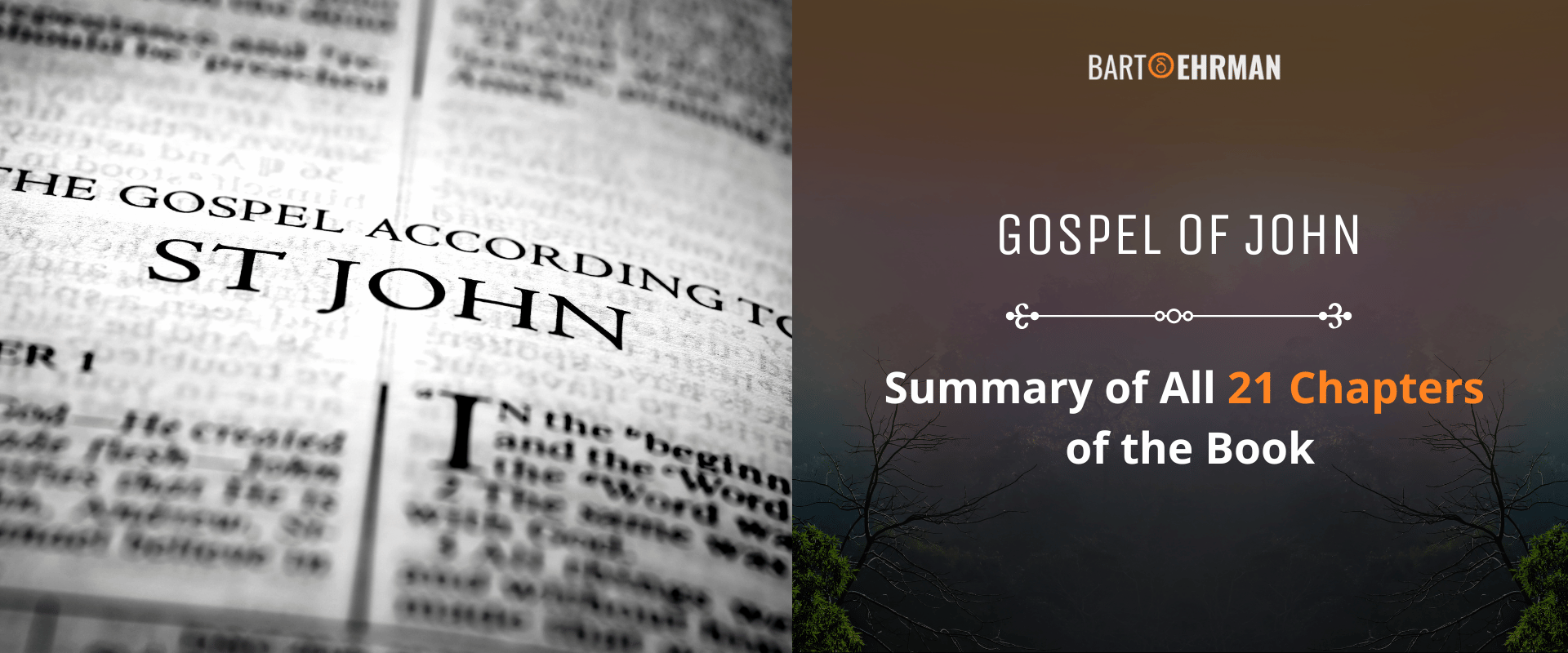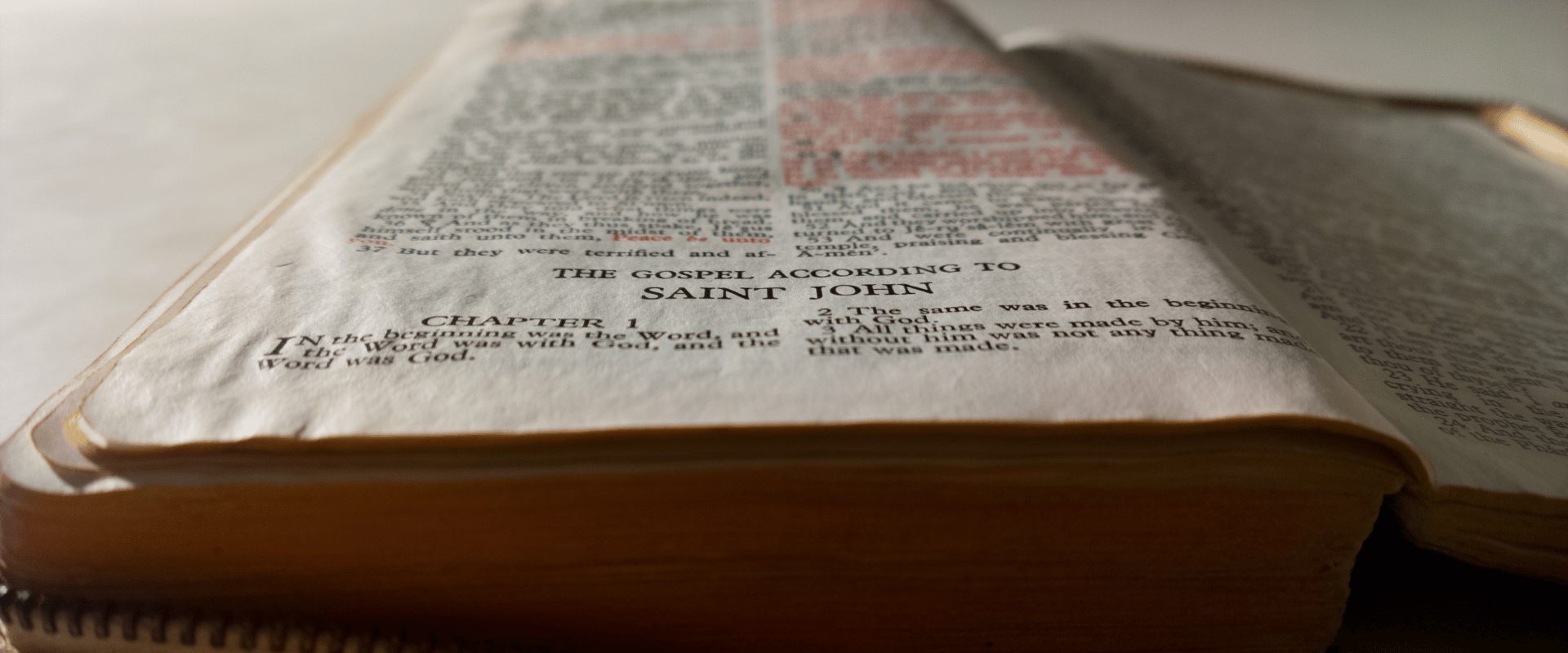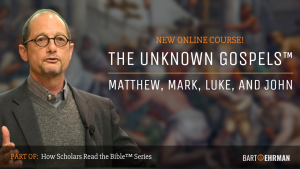Gospel of John: Summary of All 21 Chapters of the Book

Written by Joshua Schachterle, Ph.D
Author | Professor | Scholar
Author | Professor | BE Contributor
Verified! See our editorial guidelines
Verified! See our guidelines
Edited by Laura Robinson, Ph.D.
Date written: August 31st, 2024
Disclaimer: The views and opinions expressed in this article belong to the author and do not necessarily match my own. - Dr. Bart D. Ehrman
The Gospel of John is the final entry in the New Testament’s quartet of Gospels, following the accounts of Matthew, Mark, and Luke. John’s narrative offers a distinct portrayal of Jesus, characterized by cosmic theological notions and unique storytelling.
In this article, I’ll summarize the book of John with a chapter-by-chapter summary, exploring the unique way it narrates Jesus’ life, teachings, and divine purpose.

Summary of John: The Very Basics
The Gospel of John is the last of the four canonical Gospels in the New Testament canon, following Matthew, Mark, and Luke. There are 21 chapters in the book of John.
Scholars generally agree that John was the last of the Gospels to be written. In the HarperCollins Study Bible, David Rensberger notes that John presents by far the most antagonistic portrait of the relationship between Jesus and the Jews. (Affiliate Disclaimer: We may earn commissions on products you purchase through this page at no additional cost to you. Thank you for supporting our site!) However, Rensberger also notes that it is widely recognized that this represents not the situation from Jesus’ time but the circumstances of the group which the author of John belonged to decades after Jesus’ death.
In addition, Rensberger writes that when John refers to “the Jews,” he does not mean all Jewish people, since this would have to include Jesus himself as well as his disciples. Instead, this is generally John’s (unfortunate) shorthand for the synagogue authorities whom he casts as Jesus’ enemies.
For this reason, scholars generally agree that John was written very late in the 1st century, probably between 85-95 CE when some synagogue authorities were rejecting Christian claims that Jesus was the Messiah.
The book of John was written anonymously by an author who may have been representing a specific Christian community. The author’s purpose was to encourage his fellow Christians to maintain their belief during a time of persecution.
Key Themes in the Book of John
Here, I’ll give a brief summary of John, broken down into chapters and themes.
John 1:1 starts with the famous line “In the beginning was the Word.” In this prologue in 1:1-18, the author sets up Jesus as God’s pre-existent divine agent through whom God created the world. He also establishes that Jesus was divine and sent by God to assume human identity.
In this same chapter, Jesus begins his ministry by calling Andrew, Peter, Philip, and Nathanael to follow him.
In chapters 2-12, Jesus performs seven miracles. John’s Gospel calls them “signs” because they are meant to point to Jesus’ divine identity. These include the turning of water into wine at the wedding in Cana (2:1–11), the healing of the royal official’s son (4:46–54), the healing of the lame man (5:1–15), the feeding of the multitude (6:1–15), Jesus walking on the water (6:16–21), the healing of the man born blind (chap. 9), and the raising of Lazarus (chap. 11).
John 13-17 deals with Jesus’ last night with his disciples, including the Last Supper at which Jesus makes a long speech. This is the first reference in John, by the way, to “the disciple whom Jesus loved,” an unnamed person indicated as the author’s source for the life of Jesus. Traditionally, this disciple has been identified as the disciple John of Zebedee, the Gospel never says this.
Jesus’ speech at the Last Supper includes the commandment for the disciples to love each other, the assurance that though he is going away he will send them an “advocate” or Holy Spirit, and the promise that though they will be persecuted, this advocate will help them.
John chapters 18-20 deal with Jesus’ arrest, trial, crucifixion, and resurrection. After the resurrection, the risen Jesus meets with his disciples and gives them further encouragement to carry on.
Finally, John 21 tells the story of yet another appearance of the resurrected Jesus to his disciples. In this episode, Jesus specially commissions Peter to take care of his “flock” or followers. Additionally, the author indicates that “the disciple whom Jesus loved” is the one from whom he received these stories about Jesus.
Key themes throughout chapters in the Gospel of John include Jesus’ “I am” sayings, such as “I am the way and the truth and the life” (14:6) and “I am the bread of life” (6:35). These statements are unique to John and not found in any of the Synoptic Gospels.
Another focus is Jesus’ identity as the man from heaven. In Mark, Jesus’ becomes God’s Son at his baptism. In Matthew and Luke, it happens at his birth. But in John, Jesus has eternally been God’s son.
A third emphasis is the notion of the reconciliation of the world to God through Jesus. It was through Jesus, according to John’s prologue, that God made the world, which has since been corrupted. Jesus has become human to bring the world back to God.
Finally, the Doubting Thomas story, found only in John, emphasizes the importance of belief in Jesus, whether or not one has empirical evidence of him.
Next I’ll summarize each chapter in John’s Gospel, first in a table and then with a bit more explanation below.
FREE COURSE!
WHY I AM NOT A CHRISTIAN
Raw, honest, and enlightening. Bart's story of why he deconverted from the Christian faith.
Over 6,000 enrolled!
Gospel of John Summary
Chapter | Theme | Key Verse |
|---|---|---|
1 | Jesus is the eternal Word. Calls 1st disciples. | John 1:1 |
2 | Water into wine. Cleansing of the Temple | John 2:11 |
3 | You must be born again (or from above). | John 3:16 |
4 | Jesus is the living water. | John 4:14 |
5 | Jesus heals on the Sabbath. Says he has the Father’s authority. | John 5:39 |
6 | Jesus feeds 5,000, walks on water. Says one must eat his flesh and drink his blood for salvation. | John 6:54 |
7 | Jesus teaches, angering the Pharisees. | John 7:45-46 |
8 | Jesus says he’s the light of the world, emphasizing his divine identity. | John 8:58 |
9 | Jesus heals a blind man. | John 9:30 |
10 | Jesus says he is the good shepherd. | John 10:25-26 |
11 | Jesus raises Lazarus from the dead | John 11:25 |
12 | Jesus’ triumphal entry into Jerusalem. | John 12:13 |
13 | Jesus washes disciples’ feet, commands them to love each other. | John 13:34 |
14 | At Last Supper, Jesus continues teaching. | John 14:6 |
15 | Continued Last Supper speech, says he is the vine, followers are branches. | John 15:2 |
16 | Last Supper continued: Jesus says persecution will come. | John 16:22 |
17 | Jesus prays for disciples | John 17:22 |
18 | Jesus is betrayed and arrested. | John 18:3 |
19 | Pilate has Jesus beaten and crucified. His body is buried. | John 19:16-17 |
20 | Mary Magdalene discovers empty tomb. Doubting Thomas story. | John 20:29 |
21 | Jesus appears to disciples on the beach. | John 21:15 |
A Summary of John By Chapter
John 1
In the prologue to John, the author introduces his Christology — his version of who Jesus is and his significance — by saying that Jesus is the divine, pre-existent Word through whom God made all things. He also introduces John the Baptist as one who testified to others about Jesus’ role. Finally, Jesus calls his first four disciples to follow him.
John 2
Jesus performs the first of seven miracles or “signs” designed to reveal his identity. The first is turning water to wine at the wedding at Cana. Next, Jesus “cleanses” the Temple, driving the money-changers and merchants out. In the Synoptic Gospels, this happens at the end of his ministry but, in John, it’s one of his first acts.
John 3
This chapter of the Gospel of John opens with a conversation between Jesus and a Pharisee named Nicodemus. Jesus tells him that no one can enter God’s kingdom without being born from above. Many English translations say born “again” which is a possible translation for the Greek word anōthen, but “from above” better fits the context of John’s Jesus as the man from heaven.
John the Baptist later emphasizes to his followers that he himself is not the Messiah but that Jesus is.
John 4
Jesus meets a woman at a well in Samaria and demonstrates that he knows some hidden details about her life. He tells her he has “living water,” and that those who drink from this water, unlike the water from the well, will never thirst again. Jesus and his disciples then return to Galilee, where Jesus heals a royal official’s son.
John 5
Jesus heals a sick man at the pool of Bethsaida on the Sabbath. When he is accused of violating the law of the Sabbath by doing that, he claims that his authority comes from the Father. He further says that the Scriptures testify on his behalf but that “the Jews,” won’t believe. It’s important to note again here that the author can’t mean all Jews: Jesus and his disciples are Jews! He means the Jewish religious leaders only.
John 6
Jesus multiplies five loaves of bread and two fish to feed a crowd of 5,000. Later his disciples go out in a boat and are assailed by a storm. As they panic, they see Jesus walking toward them on the water. He tells them not to be afraid and climbs into the boat, whereupon the storm ceases.
The 5,000 whom Jesus fed pursue Jesus. When they find him, he gives a long discourse in which he calls himself the bread of life.
John 7
Jesus and his disciples return to Galilee. However, Jesus’ own brothers, who don’t believe in him, tell him to go to the Festival of Tabernacles (or Booths) in Jerusalem to make his ministry more public. Jesus refuses and tells them to go, but then goes to the festival secretly.
In Jerusalem, though, he goes to the Temple to teach. The religious leaders know that Jesus is uneducated, and yet he teaches as if he has knowledge and authority. Jesus says his knowledge and authority come from God who sent him. The religious leaders send people to arrest him, but they are unsuccessful. People debate whether Jesus is the Messiah or not.
John 8
While Jesus is teaching, some Pharisees bring him a woman caught in adultery and ask him if they should stone her as the law of Moses says. Jesus tells them “Let anyone among you who is without sin be the first to throw a stone at her” (8:7). The woman’s tormentors leave and Jesus sends her on her way unharmed. By the way, this story is not found in the earliest manuscripts of John and was probably added later.
Jesus says he is the light of the world and foretells his death. When he invokes the authority of Abraham, even saying that Abraham was aware of him, the religious leaders reply that this doesn’t make sense given Jesus’ youth. Jesus replies in 8:58 “Very truly, I tell you, before Abraham was, I am.” Since “I am” is the name of God in Exodus, the religious leaders attempt to stone him to death but he escapes.
John 9
Jesus heals a man born blind. When the man is questioned by the Pharisees, they confirm that he actually had been born blind. Jesus turns this into an allegory signifying the spiritual blindness of those who don’t believe in him. In verse 39, he later tells the man, “I came into this world for judgment, so that those who do not see may see and those who do see may become blind.”
John 10
Jesus says that he is the good shepherd and that his followers are his sheep. He says that a good shepherd gives his life for his sheep, a foreshadowing of his sacrificial death. Later, speaking publicly in the Temple, Jesus tells the religious leaders “The Father and I are one,” in verse 30. They again try to stone him but to no avail.
John 11
Jesus hears that his friend Lazarus, brother of Mary and Martha in Bethany, is ill. The sisters send Jesus a message, asking him to come and heal Lazarus, but Jesus takes a few days until he is told that Lazarus is dead. He comes to Bethany, where Lazarus has already been placed in the tomb. At the tomb, after telling Martha that he is the resurrection and the life, he raises Lazarus from the dead. This again angers the religious leaders who plot to kill him.
John 12
Six days before Passover, Jesus comes to Mary, Martha, and Lazarus’ home in Bethany. Mary anoints Jesus’ feet with perfume, but Judas Iscariot complains that the money for the perfume could have helped the poor instead. Jesus tells him to leave her alone and that she bought it for his burial. “You always have the poor with you,” he says in verse 8, “but you do not always have me.”
Next, Jesus makes his triumphal entry into Jerusalem, celebrated by the crowds. Later, he again predicts his death and says that he will go to it willingly because that is what God sent him to do. He says the same of his teachings, stating that God told him what to say.
John 13
Jesus and his disciples go to prepare for Passover. This chapter includes the first reference to the “disciple whom Jesus loved.” Before the meal, Jesus washes the disciples’ feet. He tells them that he is setting an example of how they should treat each other lovingly. He then begins a long speech by saying that one of them will betray him. He commands them to love one another and tells Peter that he will deny Jesus three times.
John 14
Continuing his long speech, in verses 6-7, Jesus tells the disciples, “I am the way and the truth and the life. No one comes to the Father except through me. If you know me, you will know my Father also.” Jesus is clearly divine, but the disciples appear unable to understand.
Jesus then promises that after he is gone he will send an “advocate” or “comforter”, a spirit that will be with them forever.
John 15
The speech continues in chapter 15 where Jesus says he is the vine, and his followers are branches from that vine. However, those who do not remain faithful to Jesus will be “gathered, thrown into the fire, and burned” (v. 6). He commands them to love each other as he has loved them. He promises them that as the world has persecuted him, it will persecute them as well.
John 16
Jesus warns them to stay faithful despite persecution. Again, he promises to send the advocate to them after he goes and says it will guide them to the truth. He also assures them that if they remain faithful in times of persecution, they will find joy, just as a woman suffering through childbirth finds joy afterward in her child.
John 17
The end of Jesus’ speech is a long prayer for the disciples. He says that he will soon be glorified, a reference to his death and resurrection, and asks God to protect the disciples. He asks furthermore for protection for future followers, likely referring to the author’s community.
John 18
Jesus is betrayed by Judas and arrested. While waiting to find out Jesus’ fate, Peter is accused of being a follower of Jesus and denies him three times as Jesus predicted. Jesus is questioned by the high priest and then sent to Pilate. Pilate suggests that the Jews, again the religious leaders, execute Jesus themselves. They claim that they’re not allowed to do this, although they previously tried to stone him. Pilate asks Jesus if he is a king, and Jesus replies that his kingdom is not of this world, another reference to his heavenly origins.
Pilate tells Jesus’ accusers that he finds nothing wrong in Jesus, but offers to release either him or Barabbas, who is described as an insurrectionist.
John 19
The religious leaders call for Jesus to be crucified because in calling himself Son of God he has committed blasphemy. Pilate doesn’t want to do this, but finally agrees from fear of these leaders (this is highly improbable given what we know about Pilate’s ruthlessness). He has Jesus flogged and sends him to be crucified.
Jesus is crucified, saying “It is finished” (v. 30) just before he dies. A soldier pierces Jesus’ side, and blood and water flow out. Joseph of Arimathea, a secret disciple of Jesus, asks Pilate for his body and buries him in a newly-made tomb.
John 20
Mary Magdalene goes to visit the tomb and sees that the rolling stone used to block the tomb’s entrance has been rolled away. She runs to tell Peter and the disciple whom Jesus loved. They go to the tomb and find it empty, with only the linen wrappings and head covering remaining.
After the two disciples leave, Mary stays behind, peering into the tomb. Unlike Peter and the beloved disciple, Mary sees two angels sitting where Jesus’ body had been. When she turns around, Jesus is there, although she doesn’t recognize him. However, when he speaks her name, she knows it’s Jesus. She runs to tell the disciples.
Jesus then appears to the disciples behind a locked door. One disciple, Thomas, is not present. When they later tell him, he says he won’t believe Jesus is alive until he can touch his wounds. Jesus later appears to him, allows him to touch his wounds, and says it’s better to believe without seeing.
John 21
This chapter was likely added later. Jesus appears to seven of the disciples, including Peter and the beloved disciple on the shore of the Sea of Tiberias. He specifically asks Peter to tend to his “sheep,” that is, his followers. He also hints that Peter will someday be executed.
The last few verses refer to the disciple whom Jesus loved, and say that it is this disciple who provided the stories and sayings of Jesus in this book.

Scholarly Insights About the Book of John
Before ending this article, I’d like to share some scholarly insights about it. Some of these represent scholarly consensus, while others are more controversial.
In “Parallel Traditions or Parallel Gospels? John’s Gospel as a Re-Imagining of Mark,” Mark Goodacre writes that although many scholars have assumed that the Gospel of John was written independently of the Synoptics, this may not be the case. He notes that there are, for example, a significant number of literary parallels between John and Mark in which the same wording is used. At the very least, this makes it possible that the author of John read Mark in addition to his other sources.
In the Jewish Annotated New Testament, Adele Reinhartz notes that Jesus’ calling of the disciples in John differs from that of the Synoptics in a key way: in almost every case in John, someone who already believes in Jesus brings another disciple into the fold. In the Synoptics, on the other hand, the disciples are called personally by Jesus himself. Reinhartz says the purpose of this narrative construction culminates in the Doubting Thomas story: unlike Thomas, people should believe the testimony about Jesus rather than having to encounter him personally.
In A Brief Introduction to the New Testament, Bart Ehrman notes that while the prologue of John calls Jesus the Word of God, this phrase is never used again in the book. However, many of the other sayings of Jesus do refer to the prologue.
For example, while the Word is said to have been “in the beginning” with God, in 17:5, Jesus says he possessed the glory of the Father “before the world was made.” Just as the prologue says “the Word was God,” in 10:30, Jesus says “The Father and I are one.” Finally, just as the prologue says the Word “was life,” Jesus says “I am the resurrection and the life.” In short, the prologue contains many, if not all, of the teachings about Jesus’ identity seen in the rest of the book.
Finally, most scholars for decades agreed that John was writing on behalf of a special “Johannine” community of Jesus-followers. In other words, this group was a unique community with a distinct theology. However, in his article “Did the Johannine Community Exist?”, Hugo Méndez questions this long-held assumption.
Méndez notes that this community was theorized as a way to explain the similarities of the Gospel of John to the epistles of 1, 2, and 3 John. However, he writes that “1 John, 2 John and 3 John [are] unreliable bases for historical reconstruction, whose implied audiences and situations are probably fabrications.”
In other words, while these epistles may have followed the theology of the Gospel of John, they were written to make it seem as though there was a unique community formed around the Gospel’s ideas. Instead, he says it is more likely that the Gospel and the epistles are “a chain of literary forgeries, in which authors of different extractions cast and recast a single invented character — an eyewitness to Jesus’ life — as the mouthpiece of different theological viewpoints.”
Conclusion
The Gospel of John is unique in several ways. While it shares some of the plot points with the Synoptics, it also contains many stories that they don’t have. Furthermore, Jesus’ teachings in the John’s Gospel don’t center on the Kingdom of God as they do in Matthew, Mark, and Luke. Instead, Jesus’ entire message is about his own divine identity, using miracles as signs and the metaphorical “I am” statements to communicate his cosmic significance.
Since the Gospel of John was likely written later than the Synoptics, it shows a very high, developed Christology, in which Jesus is the eternal Word of God through whom all things were made. It’s also filled with poetic and even esoteric phrases and ideas not found in the other canonical Gospels.

